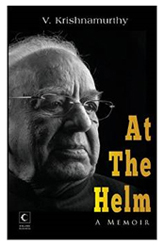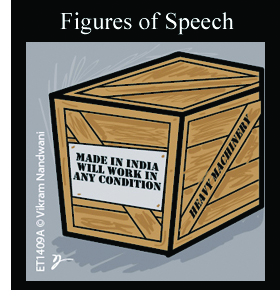
| September 2014 |
|
| Thinking Aloud | Podium | We Recommend | Standing Ovation |
| A new manufacturing revolution awaits - Jay | Interview with Viren Joshi - CEO & President, Sigma Electric Manufacturing Corporation | At the Helm - V. Krishnamurthy | Technology Informatics Design Endeavour (TIDE), Karnataka |
|
Dear Reader, India's manufacturing segment has always been a crucial cog in the wheel of the country’s economic progress. The engineering sector has witnessed tremendous growth, powered by significant investments in power projects and infrastructure development. New opportunities, such as outsourcing of engineering goods and services, new product design, product improvement, maintenance and designing of manufacturing systems are providing fresh growth avenues. With the development in associated sectors such as automotive, industrial goods and infrastructure, coupled with a well-developed technical human resources pool, engineering exports are expected to touch US$ 120 billion by 2015. Amid the many challenges that are faced in the manufacturing and exporting of engineering goods, Prime Minister Narendra Modi seeks to make the country a global hub for manufacturing through his 'Make in India' campaign, with the main focus being to build physical infrastructure as well as to create a digital network, among other objectives of this campaign. ET this month throws light on the Indian engineering exports industry. In Thinking Aloud, Jay fortifies the fact that the manufacturing sector is the backbone of the Indian economy. This is further reinforced by the ‘Make in India’ campaign which promises the success of the country’s manufacturing sector. However, the sector will have to go a long way as much needs to be done given that the manufacturing sector’s share to the GDP is just 15%, the lowest in the past 10 years. The other side are India’s engineering exports which have risen over the last few years; this segment too has great growth potential. This month on the Podium, Mr. Viren Joshi, CEO & President of Sigma Electric shares the fact that the export of Indian engineered goods is on a growth trajectory and the manufacturers competitive. Indian engineering companies have set up world class manufacturing facilities and have delivered consistently high quality precision products and systems to global customers. Mr. Joshi also backs Modi’s ‘Made in India, compete globally’ mantra. Empowered with unique demographic advantages and guided efforts, India is poised to position itself among developed economies within the next few years in the engineering goods segment. | |
|
In We Recommend, the book At the Helm authored by V. Krishnamurthy is a memoir of the author who began a career as a technician and eventually went to become one of the biggest names of the country’s public sector. The author narrates his experience and the challenges that he faced while making BHEL, SAIL and Maruti a success. He also manages to change Mrs. Indira Gandhi’s impression that Indian managers were not competent enough to manage large organisations. The book is a must read for those who wish to get a glimpse of how the public sector machinations work.
Standing Ovation features Technology Informatics Design Endeavour (TIDE), an association conceived as a link organisation between technology generating institutions and end users of technology who are most often the very disadvantaged sections of the society. The founding philosophy of TIDE has been to facilitate sustainable development in communities through technology interventions. Over a period of 20 years, in addition to fulfilling this objective, TIDE has expanded beyond technologies to offer societal solutions for water and environment, women and livelihood and local entrepreneurship. In Figures of Speech, Vikram’s package is truly ‘Made in India’. As always, we value your opinion, so do let us know how you liked this issue. To visit our previous issues you can visit the Resources section on the website or simply Click Here. You can also follow us on Facebook, Twitter, Linked In & Google+ - where you can join our community to continue the dialogue with us! | |
 |
We Recommend At the Helm - V. Krishnamurthy |
 Indian business history is largely centered around the vision and exploits of Private Family Business Leaders. And rightly so. From the days of Jamsetji Tata, G D Birla, Walchand Hirachand, and many more, the strength of the private sector has been brought to fruition by these giants. But, this is not the whole story. The Nehruvian Public Sector has played a crucial part in the industrialization of India as we must acknowledge. But, the public sector manager is largely faceless – just another government employee carrying out the diktats of the Ministry. A reasonable historian, however, would admit that some of the largest public sector enterprises had some exceptional managers who created companies that are leviathans in the national sphere. The Oil companies, the Steel Plants, State Bank of India, LIC and the Power companies, etc. are a few that come to mind. Topping this list of stalwarts who created these firms perhaps would be the name of V. Krishnamurthy. In the autumn of his life (he is 89 now), Krishnamurthy has authored his life story in ‘At the Helm’. Widely noted as the man behind the success stories of not just 1 but 3 enterprises (BHEL, SAIL and Maruti), Krishnamurthy reveals details of the challenges of being a civil servant and a public sector manager. 'People often ask me how I, with absolutely no knowledge of automobiles or steel, made a success of Marutia nd SAIL. For me, it was not important how cars or steel were made; my main task was to identify people who knew the work, wherever they were, and get them on board and also to create an environment where they could perform unhindered in a professional atmosphere. This is what I did in the three organisations that I helmed’, he says. The challenges were immense. Early in his career at BHEL, Mrs. Indira Gandhi, the Prime Minister, told him that she had no faith on the ability of Indian managers to manage large enterprises. Consequently, she wanted to split BHEL into smaller single unit enterprises. Convincing her to give him a year to prove his capability, Krishnamurthy says that ‘I did everything possible to demonstrate to her and the world that even Indian managers working under Indian conditions could manage large enterprises as efficiently as those in western countries. That became, in a sense, my driving mission.’ And, he did so outstandingly, winning multiple accolades as a technocrat par excellence over his lifetime. But life was not all smooth for him. The book reveals very briefly about the personal travails he faced in a crucial period of eight years when his name was sullied in a witch-hunt and how this took him back to his roots to the village, where for a man of science and technology, he had to take recourse to astrological advice to face the tumultuous turns in his family’s fortunes. Be that as it may, the book is recommended reading for anyone who wishes to get a glimpse of how the public sector machinations work. From lobbying by Ministers, and foreign collaborators and the lack of vision in timeserving managers, the book serves as a contrast by presenting the story of someone who made a significant difference to many sectors nationally by believing in his abilities and a deep desire to do the right and rational thing. |
 |
Standing Ovation Technology Informatics Design Endeavour (TIDE), Karnataka |
|
TIDE has a vision “to be consistently successful in addressing developmental concerns of needy communities through technological interventions.” In its quest to fulfil its mission to identify suitable technological interventions, effect improvements needed for field deployment and undertake measures to promote the spread of these technologies, TIDE has over the past 18 years associated with various partners (UNDP, DST Government of India, ETC Netherlands, British High Commission etc.) and delivered projects in the areas of:
Strengths & Competence
TIDE regularly conducts training on the construction/usage of its own technologies/products. These trainings are directed at creating entrepreneurs who can manage a small enterprise to disseminate these technologies. Thanks to this rich experience, TIDE has developed various resources ranging from manuals, movies and case studies which is scientific knowledge presented in a form useful to all. Since its inception, TIDE has in the past 20 years worked on over 200 projects experimenting with about 30 technologies and products. To know more about TIDE, please visit http://tide-india.org/. Here’s to TIDE for their noble cause for the society! |
|
|
||
|





 In 1993, Technology Informatics Design Endeavour (TIDE), an organisation in Bangalore was set up to promote sustainable development through technological interventions. TIDE aims at being a link organisation connecting research in various research institutions and the need of the community. The work of TIDE is to match the technology needs of the community with the research from the research institutions and assess their suitability, and if needed also engage with the community for participatory technology adaption and finally enable widespread dissemination.
In 1993, Technology Informatics Design Endeavour (TIDE), an organisation in Bangalore was set up to promote sustainable development through technological interventions. TIDE aims at being a link organisation connecting research in various research institutions and the need of the community. The work of TIDE is to match the technology needs of the community with the research from the research institutions and assess their suitability, and if needed also engage with the community for participatory technology adaption and finally enable widespread dissemination.